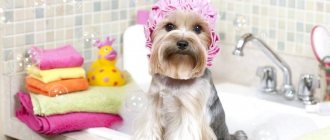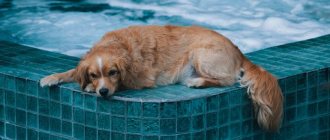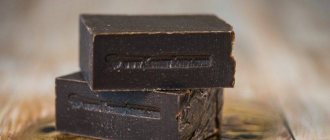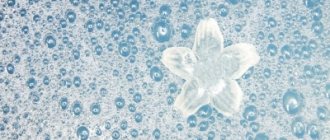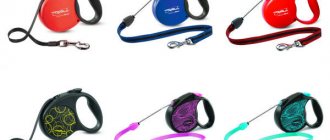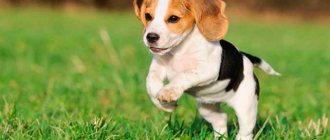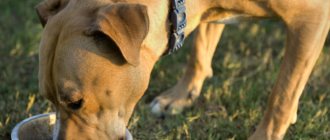The health of your pet depends on compliance with hygiene rules. Control over this aspect of the life of four-legged friends falls on the shoulders of the owners. Despite the fact that animals carry out many grooming procedures independently, in a number of situations they need help. This is especially true for cleaning limbs. Read on to learn how to wash your dog’s paws after a walk and what devices have been developed for this.
How to wash your dog's paws after a walk?
Risk of infection and general health
Think about all the surfaces your dog puts his paws on. Now imagine what bacteria and microbes can get into cracks in the skin. The dog's body can cope with bacteria, but only within reasonable limits.
How can you tell if your dog's paws are okay? Just smell them. If you smell the aroma of corn, chips, potatoes, bacteria are already attacking the body, and the fungus is waiting for the right moment to start spreading over the skin.
Note! If you wash your dog's paws regularly, any injuries will be detected in time.
Some dogs develop interdigital cysts, which can become painful. Ticks like to hide between the toes and “suck” behind the pads of the paws. The skin of the paw pads can be injured on the asphalt, the dog can get burns or frostbite, the claws break and crack... these are just some of the possible problems, the treatment of which should be as prompt as possible.
When to wash your dog's paws
Everyone understands that a dog should be taught to wash its paws from puppyhood, but somehow they are lazy. Wet weather is an excellent reason to start training. Believe me, your pet is also not happy about the lumps of dirt that stick to his fingers and fur.
What happens if you don't wash your dog's paws in rainy weather? In addition to dirt in the house, over time, the skin on the pads will become looser and more vulnerable to injury. When the skin is constantly in a humid environment, its sensitivity increases, and this negatively affects the well-being and behavior of the pet. It follows from this that the dog’s paws must not only be thoroughly washed, but also dried after going outside.
High air temperature
Most dog owners believe that if it is warm and dry outside, then the dog cannot have dirty paws. In fact, this is not the case; dust mixes with sebum and sweat (dogs only sweat through their paw pads) and forms dirt.
In summer, in hot weather, another threat arises - burns. This problem occurs especially often if the dog has to walk on asphalt surfaces. Washing paws in the summer helps the skin recover faster, which minimizes the damage of walking on hot ground and asphalt.
Snow and cold
Your feet were probably freezing, despite socks and warm shoes, your fingers were so numb that you lost sensitivity. Now imagine that you need to walk in the snow wearing only socks, without shoes.
Posts 1 page 20 of 28
Share113.01.2008 14:28:23
- Author: Julia
- Beaglepups
- From: Nizhny Novgorod
- Registered: 01/13/2008
- Posts: 11
- Last visit: 05/11/2008 11:04:15
Good afternoon everyone! I am new to such a complex issue as Beagle breeding. Every day we struggle with the stubbornness of a 3.5 month old boy. Washing our paws after a walk really bothers us. After washing my four paws again (washing them carefully, with warm water in a basin), I have a bunch of tooth marks on me. My baby perceives this as some kind of terrible violence, execution. To avoid negative memories from washing his paws, I try not to scold him, but to praise him for all the successes during the procedure, but at the same time I understand that biting cannot be left without punishment. As a result, the baby does not go for walks during the day on weekdays; I cannot allow him to bite my 10-year-old daughter while washing her paws. And now we need to go for walks more often. I ask for your advice, what should we do? What to choose: carrot or stick? How to accustom a puppy to such an important procedure? Thanks in advance for your answers!
How to properly wash your dog's paws
It would seem that the answer to this question is obvious, but every third dog owner cannot correctly name all the “steps” correctly.
- Do not wash your paws right away. Secure the leash and wait 3-5 minutes.
- If your dog is very cold, dry his paws with a towel before washing.
- Never wash your paws with cold or hot water; the temperature should be at room temperature.
- Inspect the paws while washing; all injuries and cracks should be treated immediately.
Soap and water
The most common and effective option is a bucket of water and mild soap. Soap should be added to water and stirred.
We dip the paw in water, rinse it, and wipe it. This option is not convenient for everyone, since the dog puts wet paws on the floor, water spreads, and this can have a detrimental effect on the floor covering.
Paper or absorbent towels
This option has a lot of advantages:
- No need to wait.
- No wet marks are left.
- You can wipe your paws without entering the house.
There is only one minus - the financial side of the issue.
Paper towels can be used both during the rainy season and in the summer. By the way, in the summer, it is enough to wipe your paws with a regular cotton towel. If you want to keep your home clean, you should moisten the towel with a spray bottle and wash it every day.
Wet wipes
Wet wipes are convenient because they can be used at any time of the year. It is important to pay attention to impregnation! Choose unscented baby wipes. Often, scented wet wipes are soaked in cheap, diluted liquid soap, which is bad for skin health.
The best wet wipes for paws
Farmaks Ida for a walk
These wet wipes are suitable for removing dirt from both the paws and fur of a dog or cat. They easily remove not only dust, but also chemicals or cosmetics.
The main components of such wipes are chamomile extracts, allantoin and tea tree oil. With their help, they will have an antimicrobial and anti-inflammatory effect. They will also help to heal small wounds and cracks faster and soften the skin. To make the fur shiny and soft, the manufacturer included lanolin and special additives that have a conditioning effect.
The average cost is 350 rubles.
Farmaks Ida walk napkins
Advantages:
- Suitable for paws and fur;
- Contains plant extracts;
- Softens the skin well;
- Has a healing effect;
- Convenient packaging.
Flaws:
- Not detected.
Doctor ZOO
These wet wipes can be used at any time of the year. They will be especially indispensable in winter, since they are good at removing de-icing agents from paw pads.
Since the reagents used to combat ice have a negative effect on the soft pads of the paws, the paws need special care in winter. With the help of Doctor ZOO napkins, it will not be difficult to cope with this problem. The product contains glycerin, which will have a moisturizing and nourishing effect.
The average cost is 50 rubles.
Doctor ZOO wipes
Advantages:
- Suitable for use at any time of the year;
- Moisturizing and nourishing effect;
- Convenient packaging;
- Suitable for cats and dogs.
Flaws:
- Not detected.
Teddy Pets
With the help of such wipes, caring for your pet's paws will not cause any difficulties for the owner. They will not only help get rid of impurities, but also have moisturizing and healing properties.
The impregnation of the wipes contains vitamin E and shea butter, thanks to which the skin will receive the necessary nutrition. These components also help in healing cracks and soothe itching and irritation.
The average cost is 110 rubles.
Teddy Pets napkins
Advantages:
- They have a pleasant aroma;
- Softens paw pads;
- Helps in wound healing;
- Affordable price.
Flaws:
- Not detected.
How to properly wash your dog's paws after a walk
You should definitely wash your dog’s paws after going outside, even if you don’t consider yourself a clean person. This procedure is needed not only to maintain order in the house. In winter, paws are exposed to reagents that are sprinkled on ice, and in the warm season, the dog can step into gasoline, motor oil, or chemicals of unknown origin.
If you do not wash your paws from caustic substances in time, this can lead to burns or skin irritation. In addition, the animal can lick its paws and become poisoned. You should wash your paws more thoroughly than usual after visiting the veterinary clinic. On their paws, pets bring pathogenic bacteria and worm eggs into the house. Without paying due attention to paw hygiene, you risk harming the health of not only your pet, but also family members, as well as other pets, if you have them.
Let's figure out what and how to wash your dog's paws to avoid trouble, as well as make washing quick and comfortable.
What hides in the street dirt
Dog paws harbor far more germs than car tires or dirty shoes. According to statistics, their number reaches 420,000.
Ominous statistics:
- 27% of bacteria are considered deadly, such as the E. coli virus.
- 96% of outdoor microbes are found in animal and human feces.
- 99% continue to remain active at home.
Street dirt is teeming with thousands of harmful microorganisms
By ignoring basic hygiene rules, there is a risk of infection by pathogenic bacteria.
Table 1. Main categories of harmful organisms
| Variety | Characteristic |
| Intestinal infections | Excrement is a fertile environment for the active proliferation of microbes, including E. coli. Once caught on the paws, they remain viable for several months. |
| Toxic substances | Toxins found in the environment, such as fertilizers or chemical-soaked puddles, can settle on animals' skin. We should not forget about the possibility of developing cancerous tumors under the influence of these elements. |
Fluid regularly accumulates in the folds of the skin of the paws and under the pads. It provides a nutrient medium that promotes the development of the Proteus bacterium. Active reproduction of this microorganism provokes the appearance of a specific odor reminiscent of the aroma of popcorn.
Paws should be washed regardless of how dirty your pet is.
What you might need to wash your paws
To keep your pet's paws clean and healthy, it is advisable to purchase the following things:
- Basin with water . It is placed either near the front door or in the bathroom. If you are washing your dog in the bathtub and are concerned about clogging the drain with dirt and debris, you can place a basin or baby bath directly in the bathtub. After washing, flush the water into the toilet.
- Anti-slip bath mat . It is especially important when the dog is accustomed to jumping out of the bath on its own after washing - at this moment it is easy to slip and get bruised.
- Dog shampoo or paw soap. Buy these products only in specialized stores and do not use human ones. Shampoo or special soap can be diluted in water, or you can apply it to a sponge and wipe the dog’s paws with this sponge. Don't get too carried away with detergents. Use them on heavily soiled areas rather than on an ongoing basis as they can dry out the skin.
- A cotton towel , or better yet two. One is to put a wet dog on it, and the second is to wipe it off.
- Microfiber cloths . They are good for removing small dirt. They absorb water well, dry quickly, and do not leave lint.
- Wet wipes – these can be used after a walk in dry weather.
- Tar soap is useful if there are wounds or abrasions on the paws. It relieves inflammation and disinfects, and also accelerates the skin restoration process.
- Tweezers - in case there is debris (pebbles, pieces of glass, etc.) clogged between the fingers or under the claws.
- Autogel for hand washing . Gasoline and other automotive fluids cannot always be washed with soap, so it doesn’t hurt to purchase a special gel just in case. It removes fuel oil, oils, grease, and rust. It is unknown how a dog's skin will react to it, so only use this product when all else fails.
Avoid the dirt as you approach the house
It is better to think through the route for a walk in advance, depending on the weather. On a rainy morning, you should not walk through parks or courtyards, where you are guaranteed to get into the mud with your pet. Avoid areas with wet and loose soil, as well as areas where excavation work is taking place. When approaching the house, go around all the puddles, because the dog is unlikely to think about whether the road in front of you is clear or not. If a wayward and freedom-loving pet goes straight to a place of heavy pollution, then it is better to try to negotiate. For example, you can promise him a tasty reward for obedience - a favorite treat, which for such cases is worth taking with you for a walk.
Washing paws after a walk
Now let's move on to the washing procedure itself. In dry weather, you can do without it - just wipe your paws with a damp cloth or napkin .
When the street is dirty, you can place a basin of water at the entrance to the apartment. First, wash your pet's front paws in a basin, then place them on a towel and dry them, then wash the back paws. Wipe your stomach with a rag. If the dog is not yet accustomed to this procedure and tries to run away, you can attach the leash to the handle of the front door.
During periods when spring and autumn slush reigns in the yard, not only a rag, but also a basin of water will be powerless. You can't do this without a bath. Check the temperature of the water you use to wash your dog's paws - it should be a little cooler than for washing human hands.
If the dog is small, the easiest way is to carry it into the bathroom in your arms, put it in the sink and wash each paw in turn. To prevent a large dog from getting the floor dirty on the way to the bathroom, you will have to cover it with something.
When you have finished washing, inspect the paw pads and the space between the toes. Is everything clean, everything okay? Now you can wipe your paws dry and let your pet go in peace.
If necessary, tie to the door handle when trying to escape
If the dog tries to run away during this procedure, under no circumstances should it be allowed to jump out of the bathtub or basin with wet paws. This could put your pet at risk of injury due to slipping or a cold if he hides somewhere and sits in his shelter with wet fur for a long time.
In order to prevent escapes, it is recommended to tie the dog to the door handle while washing the paws, and if the paws are washed in the bathroom, to any holder suitable for this purpose.
There should be only a slight slack in the leash to prevent your pet from getting tangled in it or putting pressure on his neck by over-tightening the leash.
When teaching a puppy to wash his paws, it is important to remember that this procedure should evoke only positive emotions in him. If the baby is ever scared or feels uncomfortable, the adjustment process will become more difficult than it might have been initially. In order to painlessly accustom your pet to this procedure, it is recommended to pick him up by the paws more often, teach him special commands, and also often praise and reward him for endurance and patience with a treat after washing his paws.
How to train a dog to wash its paws after a walk
All your good intentions to maintain cleanliness will come to nothing if the dog resists washing. Some pets even refuse to go home because they don’t want to wash themselves!
You need to start teaching your dog good hygiene as early as possible. This is stressful for the animal, although most dogs are not afraid of water and have a positive attitude towards bathing. You should not immediately drag the puppy into the bathtub and pour water on it - teach him to wash gradually and patiently.
Hold your puppy's paws often so that he gets used to being touched and won't resist being washed in the future. After some time, connect napkins or a towel - wipe the puppy’s paws one by one and treat him with a treat. A clear “wash-treat” connection should be fixed in his head. When this happens, you can move on to a larger scale wash. Many dogs enthusiastically run to wash themselves and jump on the towel to get a reward.
Don’t put your dog in the bath straight away, start with small containers
Not all pets like bathing in the bath, and it is impossible to explain to an animal that you are not going to give it a full bath, but only want to wash its paws.
Dogs may be frightened by the sound of water running from the shower or by the fact that their paws move on a slippery surface. Often, all attempts to wash an animal’s paws in the bathtub end with the dog starting to whine, dodge the stream of water directed at him, and may even jump out of the bathtub, run away and hide.
So that the dog is not afraid of washing its paws in the bathroom, and at the same time is more relaxed about bathing, it is necessary to gradually accustom it to these procedures. At the same time, at first you do not need to try to carry them out in the bathroom, but it is better to start with smaller containers, for example, with a basin or a large bowl if the pet is a dwarf breed and wash its paws not in the bathroom, but in the hallway.
You can also purchase a special device called a paw washer, which will not only make the life of the owner and his pet much easier, but will also save them both from the need to go to the bathroom every time after a walk.
This device is especially convenient when the bathroom is located at the opposite end of the apartment and it is impractical to take the dog there after every walk.
I recommend: Pregnancy in dogs: timing, periods and features of gestation of puppies in different breeds
True, training a puppy to use a paw wash can also take some time, since not all pets like to use them.
3. Use an anti-slip mat in the bathroom from the first wash so that the dog does not get injured and feels confident.
Why and how to wash your dog's paws
Why does a dog need to wash its paws after every walk, even if it’s dry and warm outside? What means can be used for these purposes? How to carry out a hygiene procedure. What to do if your pet does not want to wash its paws. How a paw wash makes things easier for the owner.
A dog living in a house or apartment should wash its paws after every walk. This is not a whim of neat people, but a necessity, although most owners prefer to do this only during the period when there is dirt or slush on the street.
For small and medium dogs you can purchase shoes and overalls
If your dog has injured its paw and the walk will take place in inclement weather, then it is better to prepare booties in advance. Shoes are also put on dogs if they cannot be washed after returning from the street. You can buy a jumpsuit for a small dog. Wash her directly in her street clothes, and then simply remove the overalls and hang them to dry.
While washing, be sure to carefully inspect your pet's paws to promptly notice any damage. A dog may accidentally step on broken glass or pick up a splinter.
All the methods listed in this article will help you feel calmer after walks and quickly carry out the necessary procedures, which often irritate dogs and infuriate owners.
- Author: iarriba
Rate this article:
- 5
- 4
- 3
- 2
- 1
(2 votes, average: 1 out of 5)
Share with your friends!
Why does a dog need to wash its paws?
- Because of the banal dirt on the street that appears after rain or snow thawing.
2) Along with dust and dirt, at any time of the year, an animal can bring infections and helminth eggs on its pads, which are successfully spread throughout the home.
3) A pet can quietly run through a puddle of oil leaked from a car, a puddle of gasoline or other chemicals, and then bring it home.
4) In winter, sidewalks and roads are generously sprinkled with special substances so that they are not slippery, but they may well cause irritation and inflammation of the pads.
5) During an active pastime, a pet may step on a sharp fragment, nail or other object, after which a wound appears. You can notice it while washing. If the damage is not treated promptly, it may fester.
You can find a variety of products for washing limbs in the pet store: soap, shampoo, foam, gel. Some of them contain disinfecting substances, others accelerate the healing of injuries, relieve inflammation, and still others kill parasites - fleas, ticks, etc. However, you can protect your dog’s pads with shoes, then there is no need to wash them after every walk.
How to wash your dog's paws
- Fill the basin with water and check the temperature. It is important that it is warm and not hot, otherwise it will be difficult to persuade the dog to perform hygiene procedures in the future. But in winter, it is preferable to use cool water so that the pet does not suffer from sudden temperature changes.
2) Prepare a towel that absorbs water well.
3) Take a washcloth or regular dishwashing sponge, moisten it in a basin and apply detergent, foaming it well directly on the sponge.
4) Place the dog’s forelimbs in the basin, wipe them thoroughly with a soapy sponge, and at the same time inspect them for wounds, splinters, and ticks.
5) Then place your hind paws on the prepared towel.
6) Wash the hind legs in the same way and dry with a towel.
A pet should be accustomed to hygiene procedures from the first months of life, since in adulthood it will resist. If the dog has difficulty agreeing to wash its paws, then it is advisable to motivate it by giving a treat each time after the procedure is completed. Over time, the animal will get used to it and will happily begin to feed its smeared paws.
Pet stores sell special devices to make the task easier for the owner - paw washers. It is enough to insert each paw one by one inside the paw washer, where the dirt is removed with the help of brushes. The owner can only add detergent, and then inspect and dry the animal’s limbs.
Here is a video showing the paw washer and the paw washing process:
Overview of paw washers
Manufacturers produce this innovative product in many variants. Depending on the size of the pet, the following models are available:
- small - for little ones;
- medium - for average;
- large - for large ones.
Thanks to the paw washer, the process of washing limbs is greatly facilitated, and the floor in the house remains free of dirt and splashes.
Paw wash - a universal means for washing limbs
Operating principle of the device:
- Pour water and shampoo into a mug.
- Place the paw in the device and move it with gentle movements up and down.
- At the end of the procedure, wipe the animal’s limbs.
According to reviews from dog lovers, one of the advantages of this device is the absence of splashes after removing the pet’s paw from it.
Table 2. Overview of paw washers
| Variety | Characteristics |
Paw Plunger | Available in several variants. For animals weighing up to 10 kg, a small paw washer has been developed, from 10 to 30 kg - a small one, from 30 kg or more - a large one. The location of the brushes allows you to reach the most difficult to reach areas on the paw. The brushes are made of material that is gentle on skin surfaces. |
Paw Wash | Made in the shape of an elongated vase. At the top there is a rubber nozzle that prevents injury to the animal’s limbs. This model does not have a brush. The device is intended for all categories of dogs. The mechanism of action is simple: you should lower the dog’s limb into a vase, into which you have previously poured water and shampoo, and rinse it thoroughly. This device comes with a comfortable glove that can be used to remove moisture from your paws. |
Dirty Paws Footbath | This small device is a glass made of plastic. Its soft upper part does not damage the limbs during the procedure. The operating principle is similar to Paw Wash. The device comes with a dog towel made of microfiber. |
Paw Boss | Complicated option. In appearance it resembles a container with compartments. After adding detergent and water to the device, the animal's paws are cleaned with a bristle plate. The design includes a lever that turns the paw washer. Thanks to the features of this device, there is no need to change the water before washing another limb. |
Paw Cleaner | A popular, inexpensive system for cleaning moderately soiled paws, pet peritoneum and upholstered furniture. The device is based on a special brush for cleaning limbs and a microfiber nozzle for wiping them. Available in several sizes. |
Paw Plunger is considered the most popular type of paw plunger
Advantages and disadvantages of paw washers
This device has already won the hearts of many dog lovers. The American invention is successfully developing the Russian market, delighting customers with a variety of models.
Among the advantages, dog lovers note the following:
- compactness and light weight;
- the ability to take the device on the road;
- no need to transport the pet to the bathroom;
- clean floor during the procedure;
- compliance of product dimensions with the dimensions of the animal;
- ease of use;
- affordable price.
Compared to the advantages, the disadvantages of the paw wash were much smaller. Owners note that the device is not suitable for very small animals. In addition, not all pets respond adequately to this device.
Paw washers are easy to use
Frequently asked questions regarding the use of Paw Plunger
Since this device recently entered the Russian market, pet owners often have questions regarding the use of the device.
Table 3. Frequently asked questions
| Question | Answer |
| Is the device dishwasher safe? | The paw washer can be washed in the dishwasher, but not often. If the device is used daily, it is preferable to rinse it with cold water. |
| What is the purpose of the rubber layer at the top? | It prevents water from splashing out of the device. |
| How airtight is the lid? | The lid fits tightly to the device and prevents water from escaping from it. It is not advisable to store liquid inside the paw washer, since over time harmful bacteria begin to actively multiply in it. Clean water is required for each procedure. |
| What is the recommended water temperature? | This indicator depends on the weather. In hot weather, the water should be cool; in cold weather, it should be at room temperature. |
| How much water should be poured into the device? | To the level of the upper bristles. |
It is necessary to instill a love of hygiene procedures from an early age

